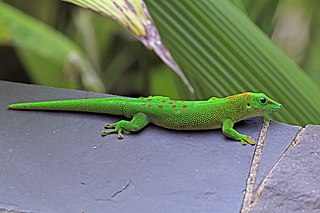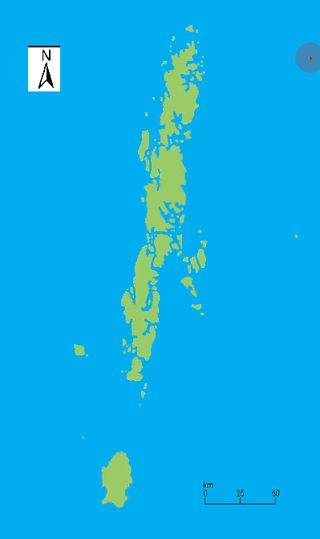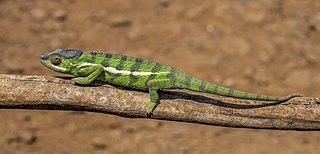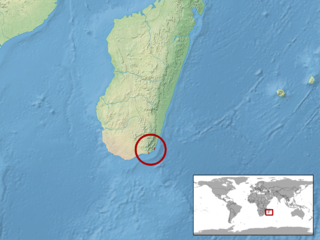
Phelsuma is a large genus of geckos in the family Gekkonidae. Species in the genus Phelsuma are commonly referred to as day geckos.

Barbour's day gecko is a species of lizard in the family Gekkonidae. The species is endemic to central Madagascar. It is diurnal and typically dwells on rocks. Barbour's day gecko feeds on insects and nectar.

The blue-tailed day gecko is a diurnal species of gecko, a lizard in the family Gekkonidae. The species is endemic to the island Mauritius. It typically inhabits warm and humid places and dwells on different trees and bushes.

The Rodrigues day gecko, also known commonly as the Rodrigues blue-dotted day gecko, is an extinct species of day gecko, a lizard in the family Gekkonidae. The species was endemic to the island of Rodrigues, where it typically inhabited forests and dwelt in trees. The Rodrigues day gecko fed on insects and nectar.

Phelsuma grandis is a diurnal arboreal species of day gecko. These geckos are part of the Phelsuma group, which consists of in excess of 70 species and subspecies. They are commonly referred to as the Madagascar giant day gecko, due to their large size. They are native to areas of tropical and subtropical forest in northern Madagascar, but have been introduced to several other subtropical locations outside their range. P. grandis feeds on various invertebrates, very small vertebrates, and nectars. It is bred and sold as an exotic pet.

Seipp's day gecko is an endangered diurnal species of lizard in the family Gekkonidae. The species is native to northern Madagascar, typically inhabits rainforests, dwells on trees, and feeds on insects and nectar.
Phelsuma parkeri, commonly known as Parker's day gecko or the Pemba Island day gecko, is a diurnal species of lizard in the family Gekkonidae. The species is endemic to Pemba Island, Tanzania, and typically inhabits banana trees and dwellings. The Pemba Island day gecko feeds on insects and nectar.

Phelsuma kely is a species of diurnal gecko. It is endemic to Madagascar and is known from the central east coast of Madagascar, south of Tamatave. It typically inhabits dragon trees. The gecko feeds on insects and probably nectar.
South Sentinel Island is one of the Andaman Islands in the Bay of Bengal. It is 1.6 km (1 mi) long northeast to southwest and up to 1 km wide. At only 1.61 km2, it is much smaller than its counterpart North Sentinel Island and is currently uninhabited. The island belongs to the Port Blair tehsil in the South Andaman administrative district, part of the Indian union territory of Andaman and Nicobar Islands, neighbouring North Sentinel Island.

Narcondam, India's easternmost island, is a small volcanic island located in the northern Andaman Sea. The island's peak rises to 710 m above mean sea level, and it is formed of andesite. It is part of the Andaman Islands, the main body of which lie approximately 74 km (46 mi) to the west.The island is part of the Indian union territory of Andaman and Nicobar Islands. The island is small, covering an area of approximately 7.6 square kilometres. It was classified as a dormant volcano by the Geological Survey of India.

Boiga andamanensis, known commonly as the Andaman cat snake, is a species of rear-fanged snake in the family Colubridae. The species is endemic to the Andaman Islands.

Bungarus andamanensis, the South Andaman krait, is a species of krait, a venomous elapid snake, which is found in the Andaman Islands of India.
Minervarya charlesdarwini is a species of frogs in the family Dicroglossidae. It is endemic to the Andaman Islands, India, and is known from the South Andaman Island, Long Island, and North Andaman Island.

The wildlife of Réunion is composed of its flora, fauna and funga. Being a small island, it only has nine native species of mammals, but ninety-one species of birds.

Phelsuma quadriocellata is a species of gecko known by the common name peacock day gecko. It is endemic to coastal eastern Madagascar, where it is a common to abundant, widespread reptile. This gecko lives in many types of low- to mid-elevation habitat types in Madagascar, including forests and areas with human activity such as cultivated land and human habitation. It is sometimes associated with Pandanus species.

Chaetodon andamanensis, commonly known as the Andaman butterflyfish, is a species of marine ray-finned fish, a butterflyfish belonging to the family Chaetodontidae. It is native to the Indian Ocean.

Phelsuma vanheygeni is a species of gecko, a lizard in the family Gekkonidae. The species is endemic to Madagascar.

Phelsuma antanosy is a species of day gecko, endemic to the coastal Anosy Region in Madagascar. The species was first discovered in by scientist Raxworthy & Nussbaum in the year 1993. Phelsuma antanosy more commonly known as Antanosy day gecko is one of 45 different species represented in the Phelsuma genus. This specific species of gecko has been placed on the critically endangered list by the IUCN red list since January 28, 2011. Little is known about the Antanosy day gecko because of its recent discovery and the small amount of research done on the species. Although, information about the geographical fragmentation and population location lead to the decision to put the gecko on the critically endangered list.

Phelsuma roesleri, also known commonly as Rösler's day gecko, is a species of lizard in the family Gekkonidae. The species is endemic to Madagascar.



















